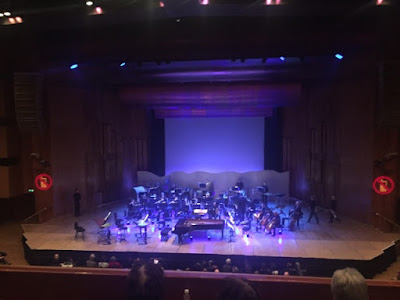Concert: Messiaen: Des canyon aux étoiles - LAPhil/Dudamel pp 23 March 2016
Messiaen: Des canyon aux étoiles (1974)
Los Angeles
Philharmonic
Cond: Gustavo
Duidamel
Joanna Pearce
Martin, piano
Andrew Bain, horn
James Babor,
xylorimba
Raynor Carroll,
Glockenspiel
Director: Deborah
O'Grady
It is a long time
since I saw Gustavo Dudamel conduct and so his appearance with the LA Philharmonic performing Messiaen's great work of God and Nature
and Man, 'Des canyons aux étoiles' was too tempting to miss.
I last saw The Dude conduct
at the Proms in 2008 where he was the star of the show. At that time he was one year into his tenure
as contract with the Gothenburg Symphony Orchestra and it was telling that he
took the august orchestra through a traditional Symphonie Fantastique (a bit
too well mannered for my taste) but also he had the place swinging from the
rafters to "Tico Tico…" as a second encore. His rise in his reputation has been meteoric - though his time
at Gothenburg wasn't marked with more than the three CD set and few YouTube
concerts.
For me the two stars of this performance were the orchestra's pianist Joanne
Pearce Martin and the Principle Horn Andrew Bain. Both had there own solo movements of
Messiaen's fiendish but hypnotic writing.
And their fellow soloists out front, James Babor, xylorimba and Raynor
Carroll, glockenspiel to made their mark but in solos and in ensemble with
elan. Dudamel busied himself behind them all and sat in darkness on a conductor's stool during the three solo movements
Listening to Messiaen has been a pre-occupation this last year as I have tried
to come closer to his music. My journey
with this composer has not been notable for it's depth until now. It's not easy music in some senses, so at first I tend to go with it open-eared, mindful of its presence and it's effects: it can give you a lot in the same
vein as Takemitsu, Varese or Stockhausen. Later comes an appreciation of the detail and structures.
In this performance we had, projected above the orchestra, pictures and video taken
and assembled by Deborah O'Grady of the places and invocations that Messiaen
names in the piece and which he visited with his wife after accepting the
commission from Alice Tully in 1972.
These were neither always literal nor did they just pertain to the
natural world and it's birdlife: humans were featured too. My regular preoccupation with music's
ability to switch off one's interest in measured time was satisfied in a surprising way by both sound and vision.
The
piece itself is divided into twelve sections and those are grouped 5-2-5 into
three parts. I think the whole effect of
this performance was contemplative rather than extravagant. I came away feeling as though I'd been in a
trance both in terms of the juxtaposition of music and image and in terms of
the structures, repetitions and textures of the 12 movements. In a full concert hall (how many times does
that happen for this piece?) there's an effect which the audience bring
too - contemplation en masse. It is was intense, as was the
playing and Dudamel's conducting. The
music scarcely ever felt pushed or in danger of putting localised effect over
longer term presence. The solos were
rich in nuance and feeling - powerful at times, haunting at others - Bain's
quiet headnotes in V came from another world. Martin was front and central and so
her concentration and physicality were palpable - somewhat ironically this is very hard music for a grand piano to deliver with the
required terse explosive capability of a small bird. The two piano solos - extensions one might
say to Messiaen's Catalogue d'oiseaux -
VI 'Le cossyphe d'Heuglin' (The White-Browed Thrush) and IX 'Le moqueur
polyglotte' (The Mockingbird) were superbly doneby Joanne Pearce Martin
and one wondered after cluster chords, irregular rhythms and those explosive
utterences how she managed the switch between solo and ensemble. Messiaen offers the player no respite.
As far as I can see this was the orchestra's first outing with the piece this season. O'Grady's visuals were first seen at Walt Disney Hall in LA earlier this season with David Robertson (who suggested the marriage of sound and image) leading the St Louis Symphony which provided the music. It may be that Dudamel gets more comfortable with the music over time - I hope it doesn't lose it's transcendental quality. This performance wasn't without it's moments of heady musical moment, but the impression I came away with was a performance which was a deep meditation on Nature and Space and Time. Thanks to the detailed attention and a considerable and considered effort to retain the mystery and allusion within Messiaen's writing to a tightly packed concert space in London. I've never been to these open spaces but I have thought about nothing much else since.
As far as I can see this was the orchestra's first outing with the piece this season. O'Grady's visuals were first seen at Walt Disney Hall in LA earlier this season with David Robertson (who suggested the marriage of sound and image) leading the St Louis Symphony which provided the music. It may be that Dudamel gets more comfortable with the music over time - I hope it doesn't lose it's transcendental quality. This performance wasn't without it's moments of heady musical moment, but the impression I came away with was a performance which was a deep meditation on Nature and Space and Time. Thanks to the detailed attention and a considerable and considered effort to retain the mystery and allusion within Messiaen's writing to a tightly packed concert space in London. I've never been to these open spaces but I have thought about nothing much else since.



Comments